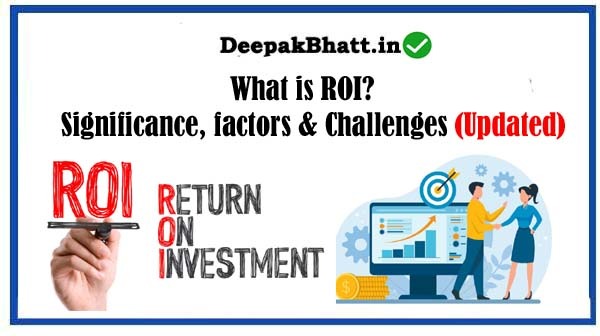Return on Investment (ROI) is a financial metric that measures the profitability of an investment relative to its cost.
It is expressed as a percentage and provides a straightforward way to evaluate the efficiency and success of an investment. The formula for calculating ROI is:
ROI=(NetGainorLoss/ CostofInvestment)×100
In essence, ROI is a tool to assess how effectively capital is employed to generate returns, making it a cornerstone metric for investors, businesses, and decision-makers across various industries.
What is Income Statement? Components, Analyzing & Futures
What is Capital? Defination, Types & Concept
What is Loss? Defination, Types & Concept
What is Divident? Defination, Types & Concept
Significance of ROI
1. Profitability Assessment:
ROI is a direct indicator of an investment’s profitability. It enables stakeholders to compare the returns generated by different investments and make informed decisions about where to allocate resources.
2. Investment Efficiency:
By considering the cost of an investment in relation to the returns, ROI measures how efficiently capital is deployed.
This efficiency metric is crucial for optimizing investment strategies and resource allocation.
3. Risk Evaluation:
ROI provides insights into the risk-return tradeoff. Investments with higher potential returns often come with increased risk.
By evaluating ROI alongside risk factors, investors can make more balanced and informed decisions.
4. Performance Benchmark:
ROI serves as a benchmark for evaluating the success of a project, campaign, or business venture. It enables businesses to set realistic expectations and measure performance against predefined goals.
5. Decision-Making Tool:
Whether for individuals, businesses, or investors, ROI is a powerful decision-making tool. It helps in prioritizing investments, optimizing marketing strategies, and steering financial decisions in the direction of maximum returns.
Calculating ROI: A Deeper Dive
1. Basic ROI Formula:
The basic formula, as mentioned earlier, compares the net gain or loss from an investment to its cost, expressing the result as a percentage.
2. Return on Equity (ROE):
ROE is a variation of ROI specifically applied to equity investments. It is calculated by dividing the net income generated by an investment by the equity invested.
ROE=(NetIncome/EquityInvested)×100
3. Return on Assets (ROA):
ROA assesses the efficiency of assets in generating returns. It is calculated by dividing the net income by the average total assets.
ROA=(NetIncome/AverageTotalAssets)×100
4. Return on Investment Ratio:
This ratio considers the cost and gain over a specific period and is expressed as a percentage.
ROI Ratio=(Gain−Cost/Cost)×100
What is Interest? Defination, Types & Concept
What is Budgeting? Defination, Types & Concept
What is Income? Defination, Types & Concept
Practical Applications of ROI
1. Investment Decision-Making:
Investors use ROI to assess the potential returns and risks associated with different investment opportunities. It helps in comparing investments and making decisions aligned with financial goals.
2. Marketing Campaign Evaluation:
Businesses evaluate the effectiveness of marketing campaigns by calculating ROI. This involves assessing the returns generated against the costs incurred, aiding in optimizing marketing strategies.
3. Capital Expenditure Analysis:
For businesses, ROI is crucial in evaluating capital expenditures. It helps in deciding whether investments in equipment, technology, or infrastructure are justified by the expected returns.
4. Real Estate Investment:
In real estate, ROI is used to assess the profitability of property investments. It considers factors such as rental income, property appreciation, and operating costs.
5. Project and Business Performance:
ROI is applied to assess the performance of projects and overall business initiatives. It aids in identifying areas for improvement, optimizing resource allocation, and ensuring strategic alignment.
Factors Influencing ROI
1. Time Horizon:
The duration of the investment significantly impacts ROI. Longer-term investments may yield higher returns but often come with increased uncertainty.
2. Risk Tolerance:
Risk is inherent in investments, and individual or organizational risk tolerance plays a crucial role in determining the acceptable level of risk for a given ROI.
3. Market Conditions:
Economic and market conditions can influence the returns on investments. Factors such as interest rates, inflation, and market trends contribute to the overall ROI landscape.
4. Industry and Sector:
Different industries and sectors have varying risk-return profiles. Understanding the dynamics of a specific industry is essential for accurate ROI assessments.
5. Management and Strategy:
The effectiveness of management decisions and strategic planning plays a pivotal role in determining the success and ROI of an investment.
Master the Basics of Finance for professionals Video Course
Business Finance Essentials Fundamental Concepts with Tutorial
Financial Ratios Practical guide For finance students
What is Financial Intelligence Basic Course with Video
Challenges and Considerations
1. Incomplete Information:
Obtaining comprehensive data for ROI calculations can be challenging. Incomplete or inaccurate information may lead to distorted ROI figures.
2. Intangible Factors:
Some returns, especially in areas like marketing or brand building, are intangible and challenging to quantify. Incorporating these factors into ROI calculations requires careful consideration.
3. Changing Variables:
Variables such as interest rates, inflation, and market conditions are subject to change. These changes can impact the accuracy of ROI projections.
4. Accounting Methods:
Different accounting methods can influence ROI calculations. Consistency in accounting practices is crucial for meaningful comparisons.
Future Trends in ROI Analysis
1. Integration of ESG Metrics:
The growing emphasis on Environmental, Social, and Governance (ESG) factors is influencing how ROI is evaluated.
Integrating ESG metrics into ROI analysis provides a more holistic view of investment performance.
2. Advanced Analytics and Artificial Intelligence:
The use of advanced analytics and artificial intelligence is enhancing the accuracy and efficiency of ROI calculations. Predictive analytics can provide insights into future returns and risks.
3. Blockchain Technology:
Blockchain technology is gaining traction in finance. Its transparency and security features have the potential to enhance the accuracy and trustworthiness of ROI calculations.
Conclusion
In conclusion, Return on Investment (ROI) is a versatile metric that transcends industries and financial domains.
It is a guiding light for investors, businesses, and decision-makers navigating the complex landscape of financial decision-making.
As financial landscapes evolve and new technologies emerge, ROI remains a timeless benchmark for assessing the efficiency and success of investments.
Welcome all of you to my website. I keep updating posts related to blogging, online earning and other categories. Here you will get to read very good posts. From where you can increase a lot of knowledge. You can connect with us through our website and social media. Thank you







